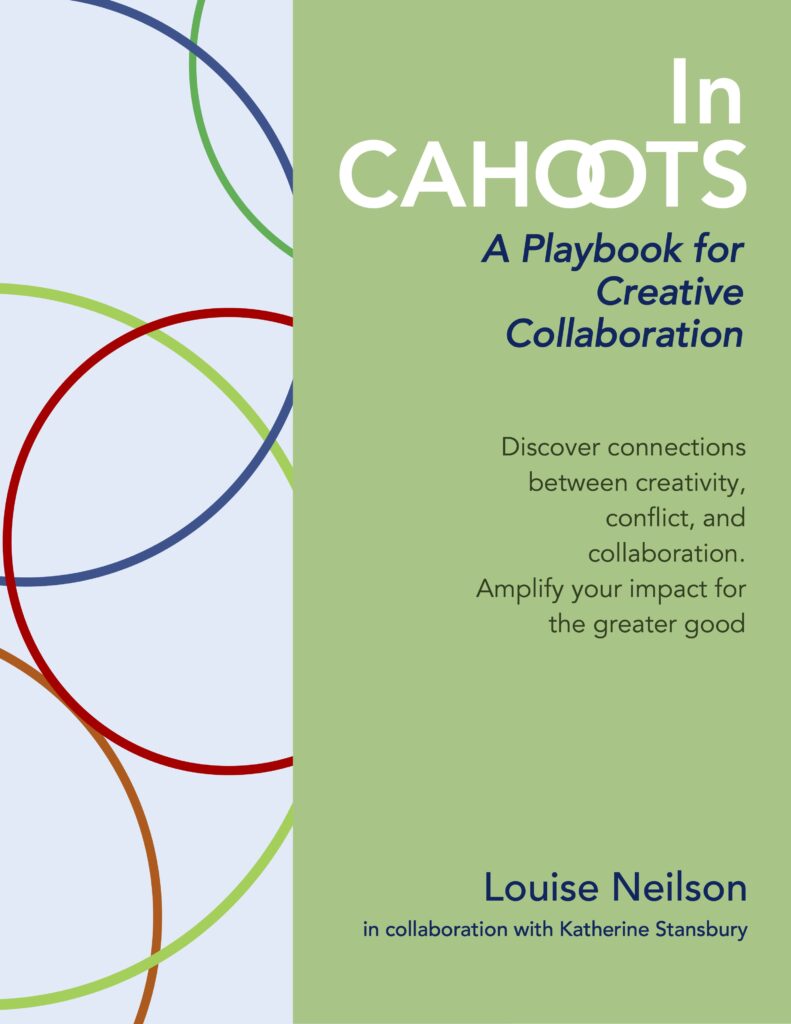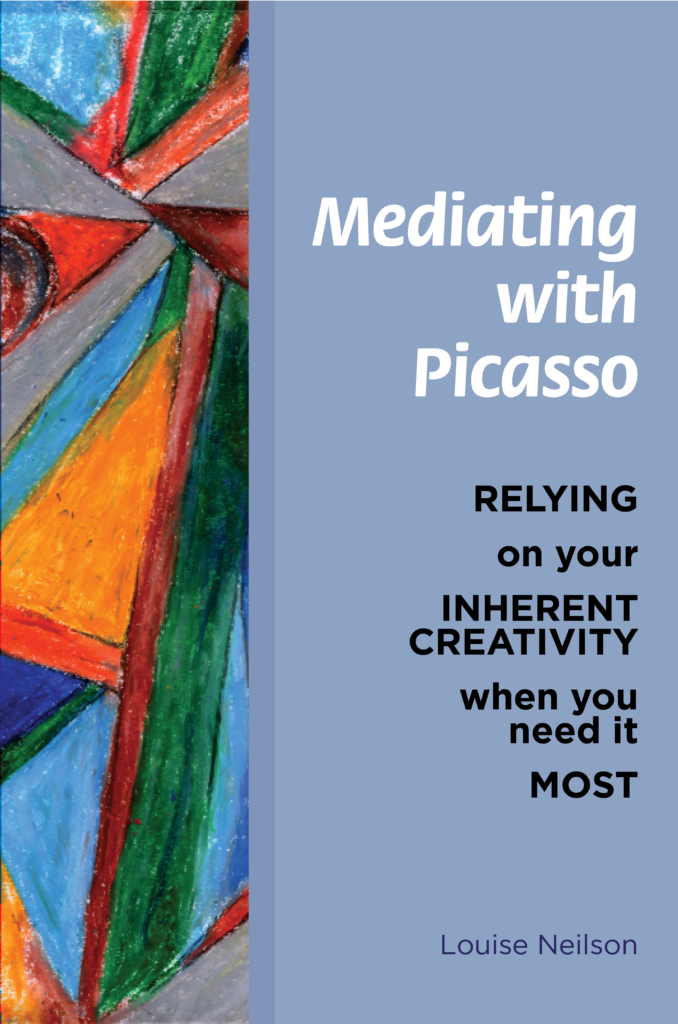


In Cahoots: A Playbook For Creative Collaboration
Louise Neilson—Creative Strategist, Mediator, Author
What if?
- What if you could help accelerate needed paradigm changes?
- What if you could create alternative futures?
- What if you used your interpersonal creativity to get us there?
Explore how you can form and sustain unlikely partnerships to take action necessary for the common good—the greater good.
Commit to using your interpersonal creativity to best invent and advance the change you support. Action instills belief, which inspires further action. The most effective way to bring about action is in cahoots with others.
When you learn new ways to relate more effectively with others you become a force multiplier; that factor that dramatically increases the effectiveness of the entire group. Then your unique contributions lead to better, more efficient group functioning toward whatever goal you are trying to accomplish.
First, In Cahoots is an opportunity for you to look inward to acknowledge your preference for how you use your creativity—as an idea generator, clarifier, developer, or implementer.1 You’ll discover that you’re more creative than you currently think you are. Next you’ll explore and begin to own the multiple elements of your interpersonal creativity. Then strategize how to put them to use for the common good. Part of that is to also acknowledge your internal barriers to effective collaboration.
Then In Cahoots looks outward at the interpersonal challenges you’ll face being in cahoots with others. The tools, techniques, and sound advice presented are highly relevant across a wide variety of small- and large-group situations. You’ll come away with new insight, skills, and wisdom that will increase your possibility of success in those groups. These principles, methods, and tactics are especially relevant in the face of the current social challenges we face.
Everyone is inherently creative, creativity is relevant, creativity causes conflicts, yet conflict is necessary to generate the creative thinking necessary to resolve conflicts. Blocks to creativity are causes of conflict, which in turn, flip back to being barriers to your creativity. I demystify these principles to make them easy to understand—and actionable.
Finally, In Cahoots invites you to look forward. Ignite your thinking by asking yourself “What If..?”. Read about real-time opportunities for a variety of ways to be in cahoots.
- What if there was more cooperation and joint trust-building among emerging groups who are organizing, mobilizing, and working with one another for positive change?
- What if we could create the alternative futures we seek?
Through your insights and experience, and through the stories and case studies presented, In Cahoots will provide you with a deeper understanding of yourself as an interpersonally creative person. Ask yourself…
- What if you’re more creative than you thought you were?
- What if you acknowledged your limits, were clear about what you can and cannot do, and trust the other people involved?
I wrote In Cahoots because I want to put creativity and imagination back into thinking about the kind of future we might create together. You have the enormous potential, the opportunity, and the responsibility to create future possibilities for the greater good.
- What if you put your interpersonal creativity to its best use?
- How might you use your interpersonal creativity to imagine harder?
- How might you succeed at work that has real value to you and your community?
“For those who seek to positively impact human challenges in collaborative ways, In Cahoots offers a realistic guide to navigating the conflict that is a natural outcome of creative curiosity and inclusive collaboration. Ms. Neilson offers a warm invitation, and an understanding of our internal makeup, that creates an insightful foundation for both creativity and conflict. She offers accessible guidance for individuals and teams to use that knowledge to link arms and work together toward progress.
Louise Nielson is masterful and fearless in her understanding of human behavior and the power of creativity, connection, and a good dose of wit in navigating and learning from interpersonal conflict. The collection of self-awareness, skill building, and play by play instructions in this book will be valuable for all leaders, team members, teachers, committee members and individuals who desire to contribute to the collective good.“
Tanya Young Stump, Director of Culture and People Development, Truss Works


Mediating With Picasso: Relying on Your Inherent Creativity When You Need it Most
Louise Neilson—Creative Strategist, Mediator, Author
This book will…
- Increase your level of creativity regardless where you start.
- Inform and foster your growing awareness of your personal creative qualities.
- Explore how those characteristics influence your mediation practice.
This is a creativity book for …
- The already self-acknowledged creative mediator
- The aspiring creative mediator
- potentially creative mediator
- Anyone else who is willing to entertain the notion that they are creative and can allow themselves to become more creative in their mediation practice
Mediation with Picasso is set forth in three sections. Physiological, neurological, and cognitive aspects of creative thinking are discussed throughout. Read the Table of Contents to decide for yourself what you want to read first and what you’ll want to read later.
The first section, A Blinding Flash of the Obvious, will convince you that you are more creative than you realize. It presents research from the fields of creativity, psychology and neuroscience. It superimposes the classic research on architects as a special group of creative persons onto mediators, demonstrating that the same characteristics are present among both groups. Research from other early and contemporary creativity scholars expands the discussion to include additional creative traits, including self-actualizing creativity, personality types, creative styles, plus brain research that further demonstrates creativity among mediators.
Section two, Thinking About Creativity, explains how “creativity” got a bad name, some of its common misconceptions, including those about the Creative Problem Solving process. It presents a wider view of different types of creativity research, and the power of metaphorical thought on creative thinking.
Section Three, Mediating with Picasso enhances your ability to mediate with a Picasso mind. It delves into the personas we inhabit when we mediate, invoking the improvisations that foster our perceived impartiality as we overcome the parties’ blocks and barriers to creative thinking Situational leadership from the world of business, personality type theory, research on narcissism, and metaphors are all applied to mediation as a means of opening up your mind to outside constructs that can enhance your latent ability to stay creative under pressure.
It has a unique format, based on brain research about learning. The prose is on the right-hand pages, while the left-hand pages contain tips, quotes, summaries of key points, reminders of main concepts, plus graphs, drawings. Glance over them as you read the right-hand pages to help you store and retrieve information more efficiently. Some left-hand pages containing surveys, check lists, and questionnaires. Use these to pause, reflect and validate in your own experience the information presented on the right-hand pages. Note the steps listed to the left.
Examples and stories are included as sidebars. Throughout, pay attention to what the sidebars remind you of. It might be some forgotten incident or something you read or heard long ago. That’s your intuition providing memory and insight to your reading. When that happens, pause, and ask yourself, “Why did I remember that particular thing?” “What’s its connection to what I’m reading?” Pay attention to those Ahas; those oblique mental connections. Your intuition is informing you of something relevant to the moment. Too many valuable creative ideas are lost because they weren’t written down for future reference. Note Ahas! as you come across them. Don’t wait. This book is meant to be used, not just read.


Mediating With Picasso Workbook
Louise Neilson—Creative Strategist, Mediator, Author
The Workbook is your place to confirm, validate, and practice your creativity. In it you can generate your individual Creative Assessment Summary, and from that, formulate your Personal Creativity Profile.
Mediating with Picasso introduces you to Abraham Maslow’s research on correlations between creativity and self-actualization, and Donald MacKinnon’s research on creative architects. Experienced, dedicated mediators, as a group, exhibit the same traits as creative architects, warranting the recognition of mediators as a distinct group of creative people. Traits you share with creative architects include certain aspects of your socialization and interpersonal behavior, the richness and complexity of your psychological development, and your degree of mental health. Without these traits you could not be an effective mediator.
The first three of the surveys here in the Workbook are based on Maslow’s and MacKinnon’s research. The rest are based on the researched conclusions of other experts in specific subject areas. Taken together the surveys from these different viewpoints will give you an assessment of your creativity as well as provide useful insights into its many facets.
Complete the surveys and exercises in conjunction with your reading of the corresponding chapters of Picasso. Space for notes is provided so you can journal your “Ahas!” as you read and complete the surveys. I hope that, as you complete the surveys here, you’ll realize, “Wow, I’m more creative than I thought!” At first your realization may be fleeting, but as you continue to substantiate it in your own experience, you will be able to sustain your realization that you are more creative than you thought you were. As I say in Picasso, you’ll see it when you believe it!
At the end of each chapter is a section titled “Taking It Forward.” The various subject areas of the Picasso chaptersare summarized here. The left columns of these pages contain lists of topics discussed in the chapter. Here you can note those that you found particularly interesting, intriguing, and will be useful to you in the future. As you respond to the exercises and surveys in the Workbook, your Reticular Activating System will make connections between what you have been reading in Mediating with Picasso and how you might apply the information to your life as well as your mediation practice.
The space in the right columns of the Taking It Forward pages is for you to note applications to your practice. The concepts will then be more readily available for future recall.
As you self-identify your own creative strengths, add your collected insights to your Creative Assessments Summary. Track your responses to the surveys and exercises by color-coding and dating them. When you revisit the Workbook in the future, you can check your progress toward acknowledging yourself as the fully functioning, self-actualizing, creative person that you are.
Coming Soon
Instructional Support for Mediating With Picasso and In Cahoots
Louise Neilson—Creative Strategist, Mediator, Author